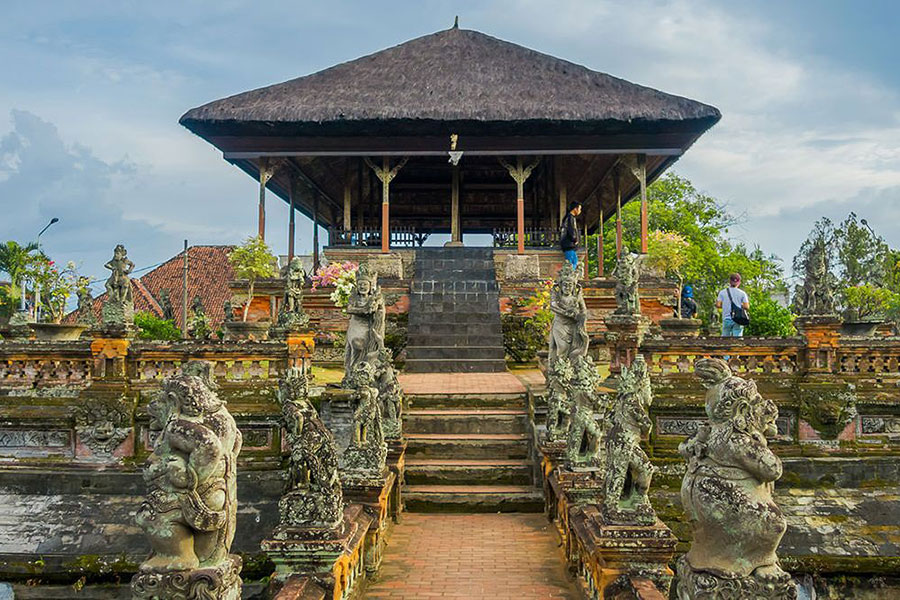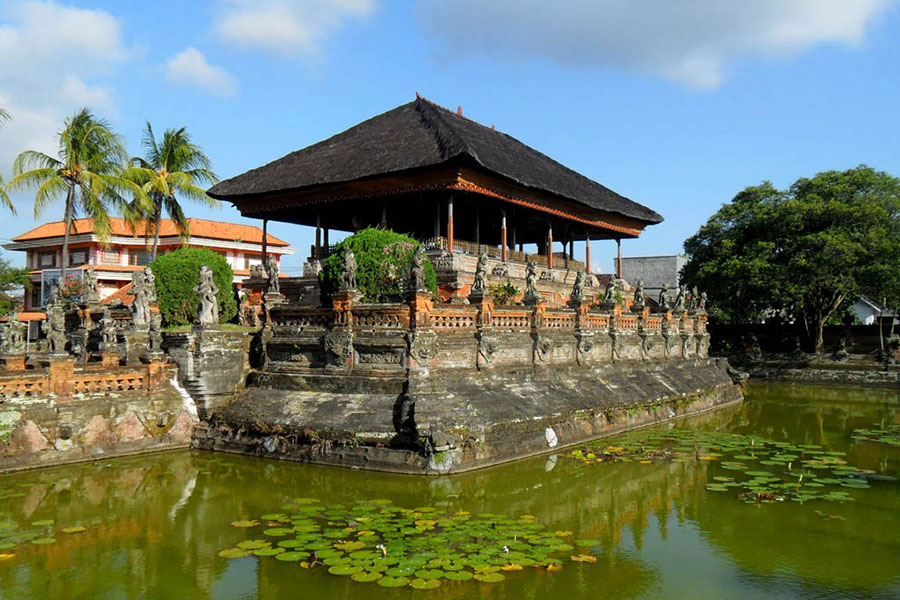BALI KERTA GOSA
BALI KERTA GOSA IS AN ANCIENT JUSTICE COURT BUILDING UPON KLUNGKUNG KINGDOM RULE

Bali Kerta Gosa is located in Klungkung Regency. In the past, this place was used as a court palace. As a former center of power, it is not surprising that Klungkung has many interesting tourist destinations. One of the Klungkung places of interest is Taman Gili at Kerta Gosa, a cultural heritage site located in Puri Semarapura Klungkung. Kerta Gosa is a building (bale) that is part of the building complex of Puri Semarapura, built around 1686 by the first leader of the Klungkung kingdom, Ida I Dewa Agung Jambe. This place is perfect to visit if you want to witness the beauty and history of Klungkung Kingdom. Apart from enjoying the architecture of Bale Kambang, you can also admire the beauty of the pool known as Gili. By looking at the traditional paintings on display at Bale Kambang, you will gain a deeper understanding of the history of the Klungkung kingdom.
If you visit Kerta Gosa Bali, here’s what you need to know:
- History of Kerta Gosa
- Kerta Gosa Complex
- The Meaning Name Kerta Gosa
- Structure Kerta Gosa Building
- Kerta Gosa and Bale Kambang
- Painting at Ceiling Kerta Gosa
- Cultural Heritage Kerta Gosa
History of Kerta Gosa
Kerta Gosa has been standing since 1700 AD. This can be confirmed by the Andra Angkala year number carved above the entrance of the Kerta Gosa complex. The andra angkala numbers consist of Cakra, Yuyu, and Paksi, which represent the year 1661 Saka, or around 1700 AD. This period is in line with the reign of King Dewa Agung Jambe. The Kerta Gosa building itself was built in 1686 by Ida I Dewa Agung Jambe, who was the first leader of Klungkung at the time. This building was part of the Klungkung royal complex in ancient times. The main function of Kerta Gosa was as a place of deliberation regarding the security situation, justice, and prosperity of the Klungkung kingdom at that time. Its function is similar to the modern court system, which provides a sense of justice and comfort for the citizens of the kingdom. During the colonial period, Kerta Gosa was also used as a courthouse from 1908 to 1942. This can be seen in the building fixtures, such as chairs and tables, that are carved and decorated with gold (prada) paint.
Kerta Gosa Complex
Kerta Gosa is a complex of buildings and a courthouse that is a legacy of the Klungkung Kingdom, which ruled from 1686 to 1908. During the Dutch colonial period from 1908 to 1942, the Kerta Gosa building continued to function as usual. Within the Kerta Gosa complex, there are several other buildings that complete the whole complex. These include the Bale Kambang in the center of the pool, known as Taman Gili, as well as the Royal Archway. On the west side of the Kerta Gosa complex, there is a building that is now used as the Klungkung Museum. The building has a European architectural style known as Balisering and was once a former Dutch school. In fact, equipment used in court, such as chairs, tables, wood carvings, and gold paint (prade), is still available and well preserved. These relics from the castle are tangible evidence of the customary institutions that prevailed in Klungkung during the Dutch colonial period (1908-1942) and the Japanese occupation period (1943-1945). This is a rich and valuable historical footprint for Klungkung’s cultural and traditional heritage.
The Meaning Name Kerta Gosa
The name Kerta Gosa comes from the Sanskrit language, which consists of two syllables, namely “Kerta” which means good, noble, safe, secure, peaceful, happy, and prosperous, and “Gosa” which means called, announced, and broadcast. Thus, Kerta Gosa can be interpreted as a place associated with achieving peace and prosperity. The name also describes the place where the king conducts deliberations regarding the peace and prosperity of the kingdom, including the areas of security and justice. The meaning of the Kerta Gosa building is closely related to the function of the royal palace, which includes elements of recreation, joy, luxury, and as a monumental piece of royal art. As a building used for judicial proceedings from the royal era to the colonial period, Kerta Gosa shows continuity in the pre-existing customary judicial procedures, even during the colonial period. This reflects local wisdom in the values of justice and openness in the legal system. Kerta Gosa provides a clear picture of the judicial process that occurred in the past and illustrates the importance of local wisdom in maintaining the values of justice and openness in law enforcement.
Structure Kerta Gosa Building
Kerta Gosa consists of two buildings (bale), Bale Kerta Gosa and Bale Kambang. Bale Kambang is so named because it is surrounded by a pool called Taman Gili. The specialty of Kerta Gosa with Bale Kambang is that the ceiling or roof of the bale is decorated with traditional paintings in Kamasan style (a village in Klungkung) or wayang style, which is very famous in Bali. Originally, the painting was made of cloth and parba, but since 1930, it has been replaced with plasterboard, which was then restored to match the original image. Today, the painting is still intact and has survived until now. As cultural heritage of the Semarapura Kingdom, Kerta Gosa and Bale Kambang were used to adjudicate cases and religious ceremonies, especially the yadnya of cutting teeth (mepandes) as performed by the king’s children.
Kerta Gosa and Bale Kambang
The function of these two buildings is closely related to education through the paintings displayed on the ceilings of the Wayang buildings. The paintings tell stories with the main theme of Swargarokanaparwa and the Bima Swarga parwa, which show the punishment of Karma Phala (the consequences of human good and bad deeds) and reincarnation due to deeds and sins. In psychological terms, the theme of the paintings adorning the ceiling of the Kerta Gosa building is very rich in mental and spiritual educational values. This painting is divided into six levels. In 1930, there was a restoration of the wayang paintings in Kerta Gosa and Bale Kambang by Kamasan artists. The last restoration of the paintings was done in 1960. Visiting this place is very useful to expand your knowledge about the history of the Klungkung kingdom, especially about the palace, where you can see historical events from the royal period to the colonial period.

Painting at Ceiling Kerta Gosa
The bottom row describes the themes of the Tantri story. The second row from the bottom illustrates the theme of the story, which follows the story of Bimaswarga in Swargarakanaparwa. The third line illustrates the theme of Bagawan Kasyapa’s story. The fourth line discusses the theme of Palalindon, which describes the meaning and significance of earthquakes in mythology. The fifth line features the theme of Bimaswarga, which is located almost on top of the conical roof. The last or sixth line depicts the life of Nirvana. In addition to the ceiling of the Kerta Gosa building, wayang paintings also adorn the ceiling in the west of Kerta Gosa Bale Kambang. On this ceiling, Bale Kambang’s wayang paintings take themes from the Ramayana and Sutasoma Kakawin stories. This theme indicates that the Bale Kambang building functions as a place for religious ceremonies, such as the Manusa Yadnya to cut the teeth of the Klungkung king’s children. In addition to the traditional Kamasan style in Bale Kerta Gosa and Bale Kambang, the attraction of Kerta Gosa paintings also lies in the pemedal agung, which is an important relic with inseparable historical value.
Cultural Heritage Kerta Gosa
The Pemedal courtyard, located to the west of Kerta Gosa, exudes a very strong sense of Puri heritage. The Pemedal Puri exhibits high artistic value with its distinctive traditional Balinese architecture. Its function as a gate is also a symbol of power, especially for Dewa Agung in Klungkung for more than two centuries (1686-1908). In the Puputan Klungkung war on April 28, 1908, which was the final battle against the Dutch forces, the last throne holder, Dewa Agung Jambe, and his followers suffered a miscarriage. A monument memorializing this event now stands at Puputan Klungkung, opposite Kerta Gosa. In the aftermath of the event, the core buildings of Puri Semarapura and the surrounding settlement were destroyed. The remaining ruins, including Kerta Gosa, Bale Kambang Taman Gili, and the Palace Portal, are focal points of interest, both in terms of tourism and cultural history studies. The Bali Driver Hire team recommends visitors visit this location for a rich experience of Balinese history and culture.

